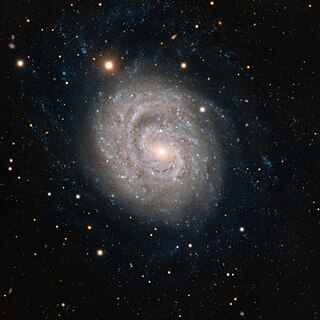Top Qs
Timeline
Chat
Perspective
NGC 1637
Galaxy in the constellation Eridanus From Wikipedia, the free encyclopedia
Remove ads
NGC 1637 is an isolated, non-interacting[7] intermediate spiral galaxy in the constellation Eridanus, about a degree to the WNW of the star Mu Eridani.[8] It was discovered by German-British astronomer William Herschel on 1 February 1786.[9][10] It is located at a distance of about 9.77 ± 1.82 Mpc (31.9 ± 5.9 Mly) from the Milky Way.[3] The galaxy is inclined at an angle of 31.1° to the line of sight from the Earth and the long axis is oriented along a position angle of 16.3°.[3]
In 1991, Gérard de Vaucouleurs and associates assigned a morphological classification of SAB(rs)c to NGC 1637, indicating a spiral galaxy with a weak bar structure (SAB) across the nucleus, surrounded by a partial ring (rs) and somewhat loosely-wound arms (c).[7] While the inner section of the galaxy shows a symmetrical two-arm structure,[6] it has a single outer spiral arm that wraps 180° around the nucleus,[6] giving the galaxy an overall asymmetric, lopsided appearance.[7] The outer spiral arm has a red component that indicates a significant age.[6] However, the existence of this structure is difficult to explain.[7] The galaxy shows indications of recent starburst activity that may have terminated around 15 million years ago.[6]
The active central nucleus shows weak LINER behavior, and it may be an intermediate form between a LINER and an H II region.[7] The luminosity of the X-ray source at the nucleus is 1.2×1038 ergs s−1 in the 0.3–7 keV band.[6]
Remove ads
Supernovae
Two supernovae have been observed in NGC 1637:
- SN 1999em (Type II-P, mag. 13.5) was discovered by the Lick Observatory Supernova Search (LOSS) on 29 October 1999, at an angular separation of 24″ to the southwest of the galaxy center.[11][12] It was the brightest supernova discovered that year, reaching magnitude 13.1.[13] The location corresponds to a deprojected galactocentric separation of 1.3 kpc (4.2 kly).[3]
- SN 2025pht (Type II-P, mag. 13.3) was discovered by All Sky Automated Survey for SuperNovae on 29 June 2025.[14]
Remove ads
Image and Video Gallery
- NGC 1637 imaged by the Hubble Space Telescope
- Video showing the location of NGC 1637
See also
References
External links
Wikiwand - on
Seamless Wikipedia browsing. On steroids.
Remove ads


